
A bunch of Kander & Ebb songs assigned to Man 1, Man 2, Woman 1, Woman 2, and Woman 3. That’s pretty much what a theater company gets when Music Theatre International grants it the rights to The World Goes ‘Round, and that’s pretty much what audiences have been getting since the Kander & Ebb revue made its Off-Broadway debut back in 1991. Five singers performing songs from the Broadway classics Cabaret, Chicago, and Kiss Of The Spider Woman and lesser know Kander & Ebb gems like The Rink, The Happy Time, and Woman Of The Year.
Audiences expecting more of the same from Actors Co-op’s intimate-stage The World Goes ‘Round can instead plan on being bowled away by director-choreographer Robert Marra’s brilliant reconception of the Kander & Ebb revue as a sung-through musical. That’s right. The World Goes ‘Round is now a bona fide musical, and which manages to tell the stories of seven authentic, distinct, fully developed characters without a word of spoken dialog.
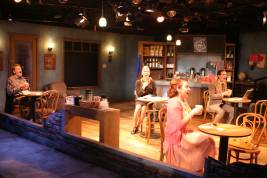 “Coffee In A Cardboard Cup” from 70, Girls, 70 (song number three in the original Off-Broadway And The World Goes ‘Round) serves as Marra’s inspiration in setting his The World Goes ‘Round revisal (the “And” got lost in the original national tour) in a New York City coffee house, where a pretty blonde Coffee Shop Girl (Kristen Heitman) serves cappuccinos and lattes and espressos to an Older Man (Robert W. Laur), a Business Man (Michael D’Elia), a Socialite (Carrie Madsen), and a Housewife (Selah Victor), as the Coffee Shop Girl’s Boyfriend (Jeremiah Lowder) and a Homeless Woman (Gina D’Acciaro) linger outside the java joint.
“Coffee In A Cardboard Cup” from 70, Girls, 70 (song number three in the original Off-Broadway And The World Goes ‘Round) serves as Marra’s inspiration in setting his The World Goes ‘Round revisal (the “And” got lost in the original national tour) in a New York City coffee house, where a pretty blonde Coffee Shop Girl (Kristen Heitman) serves cappuccinos and lattes and espressos to an Older Man (Robert W. Laur), a Business Man (Michael D’Elia), a Socialite (Carrie Madsen), and a Housewife (Selah Victor), as the Coffee Shop Girl’s Boyfriend (Jeremiah Lowder) and a Homeless Woman (Gina D’Acciaro) linger outside the java joint.
From then on, it’s songs by composer John Kander and lyricist Fred Ebb that tell the story, Marra’s stunningly conceived direction, his imaginative choreography, and the cast’s superb performances filling in the blanks between.
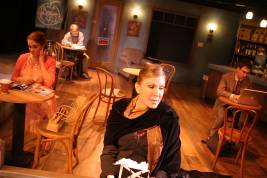 The (Widowed) Old Man reminisces about “The Happy Time” of his marriage. (“Remember the dearest love you ever knew, the day she said, ‘Hello’ to you, the happy time.”) The Socialite sorts through snapshots of past loves and recalls “Colored Lights” (despite certain memory lapses). “My Coloring Book” has the Coffee Shop Girl remembering “the heart that thought he would always be true. Color it blue.” Meanwhile, looking in from outside, the Coffee Shop Girl’s Boyfriend insists that “I Don’t Remember You” and “I don’t recall a single thing we used to say or do,” even though it’s obvious that he does. As for The Old Man, “Sometimes A Day Goes By” when he doesn’t think of his late wife, “’til morning comes and then there she is again.”
The (Widowed) Old Man reminisces about “The Happy Time” of his marriage. (“Remember the dearest love you ever knew, the day she said, ‘Hello’ to you, the happy time.”) The Socialite sorts through snapshots of past loves and recalls “Colored Lights” (despite certain memory lapses). “My Coloring Book” has the Coffee Shop Girl remembering “the heart that thought he would always be true. Color it blue.” Meanwhile, looking in from outside, the Coffee Shop Girl’s Boyfriend insists that “I Don’t Remember You” and “I don’t recall a single thing we used to say or do,” even though it’s obvious that he does. As for The Old Man, “Sometimes A Day Goes By” when he doesn’t think of his late wife, “’til morning comes and then there she is again.”
On a lighter note, the only woman the handsome but nerdy, bespectacled Business Man has in his life is “Sara Lee.” (“I love your cheesecake white as pearl, not to mention the chocolate swirl.”) Of course no one is listening when he sings because he’s an invisible “Mr. Cellophane,” that is until the Socialite goes on an older woman-younger man prowl (and “All That Jazz”) … though this might just be a fantasy, maybe hers, maybe his.
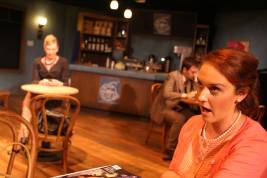 As for the Housewife, a prim and proper Donna Reed she may appear to be from the outside, but looks can be deceiving as she celebrates her “coffee in the morning, brandy in the evening,” and “Arthur In The Afternoon.” And no, we’re not talking about an appointment with the hairdresser, as the deliberate removal of her wedding ring makes abundantly clear. (Racy stuff indeed for the traditionally more staid Co-op.)
As for the Housewife, a prim and proper Donna Reed she may appear to be from the outside, but looks can be deceiving as she celebrates her “coffee in the morning, brandy in the evening,” and “Arthur In The Afternoon.” And no, we’re not talking about an appointment with the hairdresser, as the deliberate removal of her wedding ring makes abundantly clear. (Racy stuff indeed for the traditionally more staid Co-op.)
In his “new concept and characters created for this production,” Marra takes three songs from the end of Act Two and moves them up to begin the act with a contrite Boyfriend attempting to persuade his ex that “We Can Make It,” with “Maybe This Time” as her cautious response. Meanwhile the Housewife, back from her afternoon hour with Arthur reveals a deeply scarred heart in the ironic “Isn’t This Better.” (“The way it should be. Better for him. Much better for him. And also much better for me.”)
This brief (and deliberately incomplete) synopsis can only hint at just how rich Marra’s vision is, as are the unspoken back stories each performer has created for his or her character. Add to that seven actors who remain completely in character throughout, whether typing into a laptop (Business Man), doing the crosswords (Older Man), thumbing through Town And Country (Housewife), or reacting to what other characters are doing—and the result is a chamber musical that just happens to lack spoken dialog.
Other great musical moments include the Homeless Woman’s ironic “How Lucky Can You Get?,” the Business Man’s vampy transformation into sexy lady killer in “Kiss Of The Spider Woman,” and the Coffee Shop Girl, Socialite, and Housewife’s tight Andrews Sisters harmonies in “There Goes The Ball Game.”
And it wouldn’t be a Kander & Ebb revue without “Cabaret” and an unbilled post-curtain call encore that I’ll let you be surprised by.
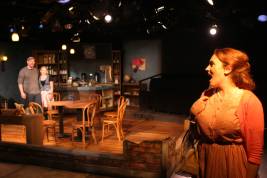 Much of the pleasure of Marra & Company’s The World Goes ‘Round is in the tiny details. There’s the wallet-sized black-and-white snapshot the Older Man shows the Coffee Girl (presumably of his wife) in “Sometimes A Day Goes By” and the caring touch she places ever so briefly on his arm. An industrial-sized box of cellophane gets used in numerous inventive ways in “Mr. Cellophane.” The Town And Country magazine the Housewife is reading throughout pays off in Act Two’s “The Grass Is Always Greener.” And speaking of payoffs, the ring the Older Man is wearing around his neck gets one of the best in “Marry Me.”
Much of the pleasure of Marra & Company’s The World Goes ‘Round is in the tiny details. There’s the wallet-sized black-and-white snapshot the Older Man shows the Coffee Girl (presumably of his wife) in “Sometimes A Day Goes By” and the caring touch she places ever so briefly on his arm. An industrial-sized box of cellophane gets used in numerous inventive ways in “Mr. Cellophane.” The Town And Country magazine the Housewife is reading throughout pays off in Act Two’s “The Grass Is Always Greener.” And speaking of payoffs, the ring the Older Man is wearing around his neck gets one of the best in “Marry Me.”
D’Acciaro, D’Elia, Heitman, Laur, Lowder, Madsen, and Victor are each and every one superb, actors who sing as opposed to singers asked to act, and it shows in their in-the-moment performances and their rainbow of reactions to what’s happening around them. Vocally, this is a particularly well-sung The World Goes ‘Round, with special kudos to Lowder’s gorgeous “I Don’t Remember You,” D’Acciaro’s rafters-reaching “How Lucky Can You Get,” and the exquisite blending of melodies and voices when Lowder’s “We Can Make It,” Heitman’s “Maybe This Time,” and Victor’s “Isn’t It Better” end up sung in counterpoint. D’Elia’s delightful “Sara Lee” and seductive “Kiss Of The Spider Woman” are stunners too, as is Laur’s show-stopping “Cabaret.” (This time it’s a man and not Sally Bowles who used to “share four sordid rooms in Chelsea” with a certain Elsie.) As for Heitman and Madsen’s “The Grass Is Always Greener,” this exercise in female bonding is such a winner, it gets a much deserved reprise.
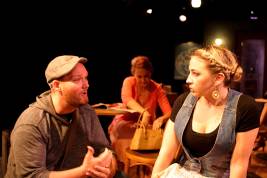 Michael Brill merits highest marks for his musical direction, the show’s live off-stage band (Jon Greathouse on keyboards, Kevin Chown on bass, and Ray Frisby on drums and percussion) sounding especially spiffy, particularly in jazzy numbers like “Arthur In The Afternoon.”
Michael Brill merits highest marks for his musical direction, the show’s live off-stage band (Jon Greathouse on keyboards, Kevin Chown on bass, and Ray Frisby on drums and percussion) sounding especially spiffy, particularly in jazzy numbers like “Arthur In The Afternoon.”
Andy Hammer’s New York City coffee house set is as richly detailed and fully realized a scenic design as you’ll ever see in an intimate theater setting, praise shared with Lori Berg’s prop design. Bill E. Kickbush’s lighting design gives each musical number its very own melody-enhancing look, and makes attention-worthy use of state-of-the-art LED stage lights. Vicki Conrad’s costumes are just-right choices for each character, with special snaps for the Homeless Woman’s transformation into Audrey Hepburn in Breakfast At Tiffany’s mode. Fritz Davis’s subtle sound design insures a perfect mix of instrumental accompaniment and vocals. (In the Co-op’s blackbox space, no body mikes are needed.)
The World Goes ‘Round is produced by Tannis Hanson. Kimberly Weber is stage manager.
If ever there was an Actors Co-op musical that deserved attention from outside the Co-op’s subscriber base, The World Goes ‘Round is that production, one which ought to have sold-out houses at every performance and “legs” that take it beyond the Co-op—to the Pasadena Playhouse? … to the Geffen? … to Off-Broadway even?
Knowing the talent involved in this production, I expected something first-rate from The World Goes ‘Round. I didn’t expect to be so completely blown away. Having now seen it, I expect that you too will be blown away by its brilliance.
Actors Co-op, 1760 N. Gower St., Hollywood.
www.actorsco-op.org
–Steven Stanley
September 9, 2012
Photos: Photos: Lindsay Schnebly


 Since 2007, Steven Stanley's StageSceneLA.com has spotlighted the best in Southern California theater via reviews, interviews, and its annual StageSceneLA Scenies.
Since 2007, Steven Stanley's StageSceneLA.com has spotlighted the best in Southern California theater via reviews, interviews, and its annual StageSceneLA Scenies.







 COPYRIGHT 2025 STEVEN STANLEY :: DESIGN BY
COPYRIGHT 2025 STEVEN STANLEY :: DESIGN BY